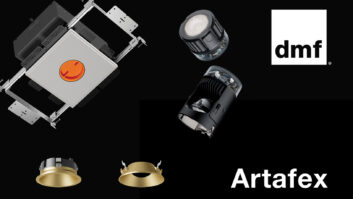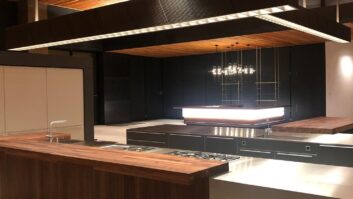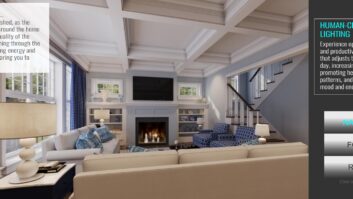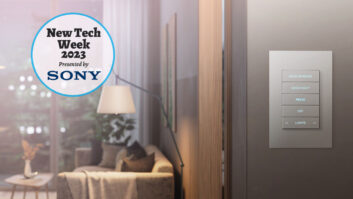Over the last six months, three major dealer buying groups–HTSA, Azione, and ProSource–have all publicly announced that they are targeting “lighting” as the next major product category for their members. But why lighting? And why now?
Jon Robbins, executive director of HTSA, stated that lighting is the natural evolution of how the industry is progressing. “Our members have been approaching it through lighting control, but that’s just one piece of the puzzle, there is so much more to Lighting, including fixtures and services,” he said. “Mainly, integrators want to be the trusted advisor for the various technologies that are going into the walls and the ceilings.”
Richard Glikes, president and COO of Azione Unlimited, said that there are a number of reasons why his group’s members should make the move. “One is that his clients are going to ask him if he can supply the fixtures, because he’s already doing the control,” he offered. “Number two is that it’s a great profit opportunity. And number three is he’s not going to install it – he’s going to make money by handing over the fixtures to an electrician…”
Dave Workman, CEO and president of ProSource, said that it really centers around the trend of the transition to low-voltage LED lighting into the emerging residential market. “As it relates to a smart home and the control aspect of it, you’ve got to tie fixtures into lighting control anyway, so it’s more elegant and more trouble-free if just one person designs the system including the lighting,” he explained.
Shining the Light on a Very Different Industry
Custom integration is a $14-billion industry. That is the sum total of all integration goods and services. Lighting fixtures alone will be a $32.5-billion business in the U.S. in 2018. And globally, lighting is expected to grow to a robust $216 billion industry by 2024. It’s a big business that’s getting bigger every day.
It is also a business with unique operating fundamentals. Light fixture manufacturers typically sell their designs through a network of lighting sales representatives and lighting distributors. Lighting sales representatives have a lot of power and set the pricing within a region, often on a job-by-job basis.
Also unique to this business is how lighting is handled in a typical residential project. Normally, a buyer seeking to build a custom home would engage some combination of an architect, a builder, and an interior designer.
The builder often has electrical contractors he prefers to work with who will commonly supply the electrical fixtures for the project. In a basic home package, the plan may simply call for two cans (fixtures) in this room, four cans in that room, etc. These are generally low cost, basic, contractor-grade, no-frills fixtures. The fact is, the consumer has a world of options with gorgeous premium decorative fixtures available, but they just don’t know enough about it to even ask.
There have been huge technological advances in lighting driving both efficiencies and comfort. There also have been dramatic scientific advances, such as circadian rhythm lighting, tunable full spectrum light, and more that can improve health and wellness in the home. These technological changes are happening so quickly that the rather staid, stuffy electrical contracting and building industries are struggling to keep up with them. But dealing with fast-paced technological changes is a pursuit at which our industry is quite adept.
Experienced AV Integrators Offer Their Advice on Entering Lighting
To discuss whether lighting is a category that you should consider entering, we invited four integrators who are deeply involved in high-performance lighting to share their insights. Andrew Davis, CEO of Maryland-based Gramophone, leads four locations in the metro Washington DC market. With three in-house lighting designers and a full electrical staff, Gramophone is very experienced providing lighting solutions. Jan Vitrofsky, founder of HED South in Hollywood, FL, is an early and progressive adopter of premier lighting fixtures. Manuel “Manny” Andalia, owner of AVL Pro in Naples, FL. The three founders’ backgrounds include an engineer, a lighting executive, and a distributor (anecdotally AVL Pro stands for “Audio, Video, and Lighting Professionals.”) Kerry Penwell of Kasted in Greenville, SC. Penwell, who started his career as a lighting designer, has two companies: Drakes Penwell Design Group, a lighting and AV design firm, and Kasted, a full-service AV integration company.
Should AV Integrators Consider Entering the Lighting Business?
Davis said that if an integrator friend called and told him that they were considering entering lighting, he would have several words of advice. “I would tell them that they need to have a great programmer who’s practically an electrician that understands the trade, and is well-versed on not only how things wire and the control system, but how it ties in with the automation and the control, he said. “I also would tell them they should be leaning on their vendors as much as possible for training and to be careful of which vendors they partner with. And finally, that having a master electrician on board, that you’ve worked with day-in/day-out, or having someone on your staff who understands electrical.”
Kasted’s Kerry Penwell wants AV integrators to look at entering lighting from a holistic perspective. “I would first make them understand that for lighting to be a success as an addition to an AV integration company, it’s not about buying and selling fixtures, it’s not about a distributor, it’s not about Best Buy, Home Depot, or CED. It’s about offering a design solution,” he said. “I would tell them to get on the front end and learn lighting design–because then you’re providing solutions–you’re not Geek Squad; you’re providing a solution to a problem that’s getting more complicated that architects need and are scared of, that interior designers need and are scared of, and that will make their jobs great, or ruin their jobs if someone does a bad job. So now, you’re that solution provider.”
Vitrofsky thinks it’s a great time to enter the category. “It’s a new narrative for you to have for your company,” he said, before adding this advice: “Get a little bit of a foundational skill set of understanding about different elements of what light fixtures are, and beam spreads, and color temperatures…we call it Lighting 101.”
Andalia laughed when asked what advice he’d have if an integrator friend called to ask about entering the category. “Well, that has actually happened,” he said. “We have had integrator friends that have contacted us and said, ‘You guys have been so successful, we’d like to do what you guys do.’ We tell them, there’s a steep learning curve, you can’t just jump into it. That’s the last thing you want to do is to jump into something and then not perform.
What Are the Hurdles to Overcome on the Way to Success in Lighting?
Our panel universally agreed that education was the first hurdle that any AV integrator must clear to have any chance of success in lighting. There is much to learn in lighting from a business perspective, and from the technology perspective. It’s not rocket science, but it is unique compared with traditional custom integration categories.
Andalia put it well, saying that you have to be educated, and that you really need to be well informed on products. “There’s a lot of people that go out there and say, ‘OK, I can design lighting,’ and they’ll just do exactly what most builders do–just throw in four contractor-grade cans into a room and put a Control4 or a Crestron or Lutron dimmer on it and say, ‘Hey, we’ve got a lighting design.’ That may be fine for a basic home…but it’s not fine for the higher level home of the typical client of an AV integrator.”
Many lighting manufacturers do not sell direct to AV integrators. This reality means you will be forced to go through a lighting distributor. For those just starting out in lighting, there really is no way to avoid it and it will cut into your margins. There may also be some friction as part of this process–local lighting reps may not necessarily welcome you with open arms.
“That’s going to be one of the biggest hurdles,” Andalia said. “There are manufacturers out there that are starting to supply lighting [to integrators], but the well-known brands aren’t always supplied [direct to AV integrators]. So you will have to go through distribution, and that’s another game to be played; there’s a difference, in ‘buying’ and in ‘buying power.’”
Vitrofsky agrees, saying, “This whole foray by AV integrators into the lighting fixture business is not being accepted very well by the 100-year-old industry that’s been in place, and which is controlled not by the manufacturer, but by the lighting rep…and that’s the biggest problem for us. You don’t make as much money selling the light fixture as you’d like to. Hopefully, this will change.”
Actually, most on the panel say they see this situation already changing for the better. As your business grows in lighting, you will be able to buy more of your lines direct from manufacturers, which will improve your profits even more.
Up to now, electricians provided the fixtures on most jobs. That means they are, in a sense, a competitor to the AV integrator, as well. Even so, the reality is that you still need to work with electricians on every job.
In the case of Gramophone’s Davis, he is firmly in the camp of having your own electrician on staff. Noting that to deliver the experience that his clients expect, Gramophone feels they need to control as much of the lighting eco-system as possible–from design through installation. Electricians, he said, are good at pulling Romex, wiring receptacles and toggle switches, but two-thirds of them are clueless about the latest high-performance lighting fixtures and emerging lighting technologies.
“It’s a whole different world now and they’re really confused with it, so they’re leaning on us,” Davis added. “We’re in a special spot because all of this is the reason why I brought in a high-voltage master electrician, and now we have 12 people running our own electrical team. We don’t tell clients that they must use our electrical team, but it does go hand-in-hand.”
AVL Pro pursues the panel’s other recommended option for integrators: building relationships with multiple electrical contractors in the market, and heading off problems by supplying them with premium fixtures. AVL Pro is able to do this because they are also a wholesale lighting distributor.
“Setting up the proper relationships with electrical contractors is a hurdle,” Andalia said. “Notoriously, there’s always been kind of a rub between AV guys and the electrical guys. It’s not an insurmountable problem if you bring added value. Say, for example, you bring the fixture and supply it to them and sell it through them, instead of being the lead, you be the partner with them so they’ll make some money on it.”
Penwell says Kasted takes a similar approach. “We are a wholesale lighting distributor, and we will sell those light fixtures at times to the electrician. It means we made less money because I have to leave margin for him. But I still sold fixtures on that project, so I still make money for all of our time and our design and all the things that we’re going to do. And the electrician made his margin as well…it’s a win-win.”
The Major Benefit of Achieving Success in Lighting
One thing that our panel universally agreed upon is this: becoming successful in lighting, especially when you offer design services, means that you become part of the project’s design team, which is formed right at the beginning of the project. This can lead to opportunities for your AV side, as you have an early “in” on the project.
“That’s a fact,” Andalia said. “When we are called by the builder or by the homeowner, they’re calling us because they want us to be part of the design team. So we have design meetings, schematic designs, we do all of the initials so everyone can review it. We meet with the customers if it’s a builder building a custom home for somebody. We’ll present the lighting plan to the client and explain all of the options that they have. It definitely gets you involved with the team, gains you the confidence of the other team members, as well as that of the builder and of the homeowner.”
And it almost always creates opportunities to provide the AV work as well, added Vitrofsky. “Once you have a little bit of the client’s money, it’s much easier for them to add more with you, rather than having to go out and try to find another contractor,” he said. “And for the client or builder, it’s one less subcontractor to deal with.”
A Dramatic Shift in Business is Coming Your Way
Most AV integrators are already approaching the lighting business by offering lighting control solutions. It is a natural progression to move from there to offering premier fixtures and other services. This reality, coupled with the dramatic technological changes taking place within the lighting segment, sets the stage for a huge shift in the lighting business in the favor of the AV integrator.
HED South’s Vitrofsky puts it this way: “You can relate the situation to another paradigm shift that we all lived through not that long ago. Consider the business model of motorized shades. Lutron put a lot of us into the shade business. Prior to that, shades were sold through the interior designer and we stole that business from them. Were they happy about that? Definitely not! But, you know, shift happens.”














